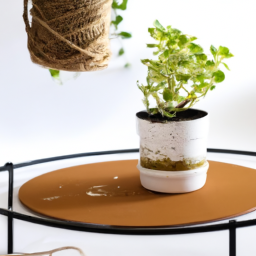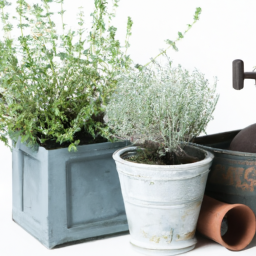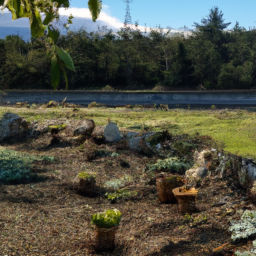
Welcome to our blog post on creating mini succulent gardens: a DIY project! Succulents have become increasingly popular in recent years due to their unique and low-maintenance nature. These adorable plants bring a touch of greenery and tranquility to any space, making them perfect for both indoor and outdoor environments. In this article, we will guide you through the steps of creating your own mini succulent garden, allowing you to unleash your creativity and add a personal touch to your living space. So, let’s dive in and discover how to create stunning and captivating mini succulent gardens that will brighten up your home or office!
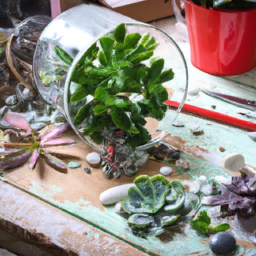
Essential Supplies and Tools for Creating Mini Succulent Gardens
Introduction
Creating mini succulent gardens is a wonderful DIY project that allows you to bring a touch of nature into your home or office. These tiny gardens not only add a pop of greenery to any space but also provide a calming and soothing atmosphere. To embark on this creative journey, you will need a few essential supplies and tools. In this guide, we will walk you through the must-have items that will help you create stunning mini succulent gardens.
1. Containers
The first step in creating mini succulent gardens is to choose the right containers. These containers serve as the foundation for your garden and can greatly influence its overall aesthetic. When selecting containers, consider the size and shape that best suits your vision. Terracotta pots, glass jars, wooden boxes, or even old teacups can all be great options for housing your succulents. Ensure that the containers have drainage holes or add a layer of pebbles at the bottom to prevent waterlogging.
When it comes to the size of the containers, keep in mind that succulents have shallow root systems. Therefore, smaller containers are often more suitable, as they provide a cozy environment for the plants. However, if you plan to create a larger arrangement with multiple succulents, a bigger container would be more appropriate.
2. Succulent Soil
Succulents require well-draining soil to thrive. Regular potting soil tends to retain too much moisture, which can lead to root rot. Therefore, it is crucial to use a special succulent soil mix or create your own by combining regular potting soil with perlite or coarse sand. This mixture allows excess water to drain away quickly, preventing the roots from becoming waterlogged.
When choosing or creating your succulent soil, ensure that it is lightweight and provides good aeration. This will allow the roots to breathe and prevent the soil from compacting over time. Remember, healthy soil is the foundation for healthy succulents.
3. Succulents
Of course, no mini succulent garden is complete without the stars of the show – the succulents themselves. When selecting succulents, consider their size, color, and growth habit. Opt for smaller varieties that will fit well in your chosen containers and create a harmonious arrangement.
There are numerous types of succulents to choose from, each with its own unique characteristics. Some popular options include Echeveria, Sedum, Crassula, and Haworthia. Experiment with different textures, shapes, and colors to create a visually appealing composition. Remember to choose succulents that have similar light and water requirements, as this will make maintenance easier.
4. Gravel or Pebbles
Adding a layer of gravel or pebbles to the bottom of your containers is not only aesthetically pleasing but also serves a practical purpose. This layer helps improve drainage and prevents the succulent roots from sitting in excess water. Choose pebbles or gravel that are small enough to allow water to flow freely but large enough to avoid clogging the drainage holes.
Additionally, you can use decorative pebbles or colored gravel to enhance the overall look of your mini succulent gardens. This layer adds depth and texture to the arrangement, making it more visually appealing.
5. Watering Can or Spray Bottle
Proper watering is essential for the health of your succulents. While succulents are known for their ability to withstand drought, they still require regular watering, albeit in small amounts. To avoid overwatering, it is best to use a watering can with a narrow spout or a spray bottle. This allows you to target the water directly at the base of the plants, avoiding the leaves and preventing the risk of rot.
Remember, succulents prefer to be underwatered rather than overwatered. It is better to underwater and adjust accordingly than to drown the plants with excessive moisture. Always allow the soil to dry out completely between watering sessions.
Conclusion
Creating mini succulent gardens is a delightful DIY project that anyone can enjoy. By gathering the essential supplies and tools mentioned above, you are well on your way to crafting beautiful and thriving miniature landscapes. Remember to choose containers with proper drainage, use well-draining succulent soil, select suitable succulents, add a layer of gravel or pebbles, and water with care. With a little creativity and attention to detail, you can create stunning mini succulent gardens that will bring joy and tranquility to your surroundings. Happy gardening!

Step-by-Step Guide to Designing and Planting a Mini Succulent Garden
Introduction
Welcome to the world of mini succulent gardens! Creating your own mini succulent garden is a delightful and rewarding DIY project that allows you to bring a touch of nature into your living space. These miniature gardens are not only visually appealing but also low-maintenance, making them perfect for both experienced gardeners and beginners. In this step-by-step guide, we will explore the process of designing and planting your own mini succulent garden, from selecting the right container to caring for your tiny green oasis.
Choosing the Perfect Container
When it comes to designing a mini succulent garden, the choice of container plays a crucial role. The container not only serves as the foundation for your garden but also adds to its overall aesthetic appeal. Here are some factors to consider when selecting the perfect container:
Size and Shape
The size and shape of the container largely depend on the number and size of succulents you wish to include in your garden. A shallow container is ideal for creating a mini succulent garden as it allows the plants’ roots to spread out horizontally. Additionally, consider the available space in your home or garden where the mini garden will be displayed. A compact, rectangular container or a round pot can fit well in small spaces, while a larger, more elaborate container can be a centerpiece in a larger area.
Drainage
Proper drainage is crucial for the health and longevity of your succulents. Ensure that the container you choose has drainage holes or can be easily modified to include them. Succulents are susceptible to root rot if their roots sit in waterlogged soil for extended periods. By allowing excess water to drain out, you can prevent this common problem and keep your mini succulent garden thriving.
Material
Containers made of materials such as terracotta, ceramic, or concrete are popular choices for mini succulent gardens. These materials not only provide a sturdy base but also allow for better air circulation, which is essential for succulent health. Additionally, the natural colors and textures of these materials can complement the vibrant hues and unique shapes of the succulents.
Selecting the Right Succulents
Now that you have chosen the perfect container, it’s time to select the succulents that will bring your mini garden to life. With their diverse shapes, colors, and textures, succulents offer endless possibilities for creative arrangements. Here are some tips for selecting the right succulents:
Variety
Choose succulents that vary in size, shape, and color to create an interesting and visually appealing composition. Combining different types of succulents, such as rosette-shaped Echeverias, trailing Sedums, and spiky Haworthias, can add depth and dimension to your mini succulent garden.
Compatibility
Consider the growth requirements of the succulents you choose to ensure they are compatible with each other. Select succulents that have similar sunlight and watering needs to make maintenance easier. Mixing succulents with similar care requirements will help prevent overwatering or underwatering, which can be detrimental to their health.
Size
Since you are creating a mini succulent garden, it’s important to choose succulents that will not outgrow the container too quickly. Opt for smaller varieties or young plants that have room to grow within the confines of your chosen container. This will help maintain the overall balance and harmony of your mini garden.
Designing Your Mini Succulent Garden
Now that you have both the container and the succulents ready, it’s time to design your mini succulent garden. Follow these steps to create a visually appealing and well-balanced composition:
Placement and Arrangement
Before planting your succulents, experiment with different arrangements by placing them on top of the soil. Consider the colors, shapes, and sizes of the succulents to find a pleasing arrangement. You can create focal points by clustering succulents of similar colors or placing taller plants in the center. Play around with different combinations until you find the perfect design that suits your taste.
Planting Technique
Once you are satisfied with the arrangement, it’s time to plant your succulents. Start by filling the container with well-draining succulent soil mix, leaving enough space for the roots. Gently remove the succulents from their nursery pots, loosen the roots, and place them into the soil. Press the soil lightly around the base of each plant to secure them in place. Avoid overpacking the container, as this can hinder proper airflow and lead to moisture-related issues.
Finishing Touches
After planting, you can add a decorative touch to your mini succulent garden. Consider using small pebbles, colorful stones, or even miniature figurines to enhance the overall aesthetic appeal. These finishing touches can also help with moisture retention and prevent the soil from drying out too quickly.
Caring for Your Mini Succulent Garden
Now that your mini succulent garden is complete, it’s important to provide the proper care to ensure its long-term health and beauty. Here are some essential care tips:
Light
Most succulents thrive in bright, indirect light. Place your mini garden near a window that receives ample sunlight, but avoid exposing it to intense, direct sunlight, as this can scorch the leaves. If you notice your succulents stretching or becoming leggy, it may be an indication that they are not receiving enough light.
Watering
Succulents have unique water requirements. Allow the soil to dry out completely between waterings, and then water thoroughly until the excess water drains out of the container. Overwatering can lead to root rot, so it’s better to underwater than to overwater. Remember, succulents are adapted to survive in arid conditions, and they store water in their leaves and stems.
Maintenance
Regular maintenance is minimal for mini succulent gardens. Remove any dead or dried leaves to maintain the overall appearance and prevent the spread of pests or diseases. If your succulents outgrow the container, you can propagate them by gently removing offsets or leaves and replanting them in a new container.
Conclusion
Creating a mini succulent garden is a delightful DIY project that allows you to express your creativity while bringing a touch of nature into your living space. By following this step-by-step guide, you now have the knowledge and tools to design and plant your own mini succulent garden. Remember to choose the perfect container, select a variety of compatible succulents, design a visually appealing composition, and provide the necessary care to keep your mini garden thriving for years to come. Enjoy the beauty and tranquility of your miniature green oasis!
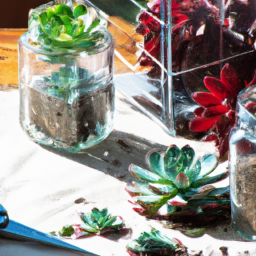
Tips for Maintaining and Caring for Your Mini Succulent Garden
Creating a mini succulent garden is a delightful DIY project that allows you to bring a touch of nature into your home. These tiny plants are not only aesthetically pleasing but also low-maintenance, making them perfect for busy individuals or those new to gardening. However, like any living thing, succulents require proper care to thrive and flourish. In this article, we will provide you with some essential tips for maintaining and caring for your mini succulent garden.
1. Choosing the Right Container
The first step in maintaining a healthy mini succulent garden is selecting the right container. Succulents have shallow root systems, so it’s crucial to choose a container with good drainage. Opt for a pot with drainage holes or add a layer of gravel at the bottom to prevent water from pooling around the roots.
Additionally, consider the size of the container. While mini succulents don’t require much space, they still need room to grow. Ensure that the container is large enough to accommodate the plants’ growth without overcrowding them.
Lastly, choose a container that complements the overall aesthetic of your mini succulent garden. There are various options available, such as terracotta pots, glass containers, or even repurposed items like teacups or mason jars.
2. Providing Adequate Light
Succulents thrive in bright light, so it’s crucial to place your mini garden in a location that receives ample sunlight. Ideally, they should be exposed to at least six hours of indirect sunlight per day. However, be cautious of intense, direct sunlight, as it can scorch the leaves of your succulents.
If you don’t have access to sufficient natural light, you can also use artificial grow lights. LED grow lights are a popular choice as they emit the right spectrum of light for succulent growth and can be adjusted to mimic natural sunlight.
Remember to rotate your mini succulent garden regularly to ensure even light distribution and prevent your plants from leaning towards the light source.
3. Watering Techniques
One of the most common mistakes in succulent care is overwatering. Succulents are adapted to survive in arid conditions and store water in their leaves and stems. Therefore, they are susceptible to root rot if exposed to excessive moisture.
When watering your mini succulent garden, it’s essential to follow the “soak and dry” method. Thoroughly water the soil until it is moist, allowing the excess water to drain out through the drainage holes. Then, wait until the soil is completely dry before watering again. Stick your finger about an inch into the soil to check for moisture.
Remember, it’s better to underwater than overwater your succulents. They can tolerate drought-like conditions for extended periods, but they won’t survive in waterlogged soil.
4. Soil and Fertilization
Succulents require well-draining soil to prevent root rot. You can either purchase a pre-made succulent mix or create your own by combining regular potting soil with coarse sand or perlite. This mixture allows excess water to drain away quickly, keeping the roots healthy.
Fertilization is not a necessity for succulents, but it can promote healthier growth and vibrant colors. Use a balanced, water-soluble fertilizer formulated specifically for succulents. Apply the fertilizer sparingly during the growing season, typically from spring to early fall, and avoid fertilizing during the dormant winter months.
Remember to follow the instructions on the fertilizer packaging and dilute it to half or quarter strength to prevent burning the roots.
5. Pruning and Propagation
Regular pruning is essential to maintain the shape and size of your mini succulent garden. Use clean, sharp scissors or pruning shears to remove any dead or decaying leaves, stems, or flowers. This not only enhances the appearance of your garden but also prevents the spread of diseases.
Furthermore, succulents are incredibly easy to propagate, making it a fun and cost-effective way to expand your collection. You can propagate succulents through stem cuttings, leaf cuttings, or by dividing offsets. Each method has its own requirements, so it’s essential to research and follow the appropriate propagation technique for your specific succulent species.
6. Monitoring for Pests and Diseases
While succulents are generally hardy plants, they can still fall victim to pests and diseases. Common pests that affect succulents include mealybugs, aphids, and spider mites. Regularly inspect your plants for any signs of infestation, such as webbing, sticky residue, or distorted leaves. If you notice any pests, isolate the affected plants and treat them with an appropriate insecticidal soap or neem oil solution.
Additionally, be mindful of diseases such as root rot, powdery mildew, or fungal infections. Ensure proper airflow around your mini succulent garden by avoiding overcrowding and providing adequate spacing between the plants. If you notice any signs of disease, promptly remove the affected parts or plants to prevent further spread.
In conclusion, maintaining and caring for your mini succulent garden requires attention to detail and adherence to specific guidelines. By choosing the right container, providing adequate light, watering properly, using well-draining soil, pruning, and monitoring for pests and diseases, you can ensure the long-term health and beauty of your mini succulent garden. Enjoy the therapeutic benefits of gardening and the joy of watching your succulents thrive!
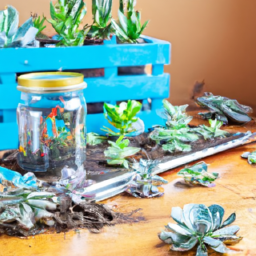
5. Creative Ideas for Displaying and Showcasing Your Mini Succulent Garden
Introduction
Creating a mini succulent garden is a delightful DIY project that allows you to express your creativity and add a touch of nature to your living space. Once you have designed and planted your mini succulent garden, the next step is to find the perfect way to display and showcase it. In this article, we will explore five creative ideas that will elevate your mini succulent garden to a whole new level.
1. Hanging Planters
Hanging planters are a fantastic way to display your mini succulent garden while saving precious space. You can find a variety of stylish hanging planters in different materials such as ceramic, macrame, or even repurposed objects like old teacups or mason jars. When choosing a hanging planter, make sure it has proper drainage to prevent waterlogging.
To create a stunning visual display, consider hanging multiple planters at varying heights. This will add depth and dimension to your mini succulent garden. You can hang them near a window, in the kitchen, or even on a patio to create a beautiful green oasis.
When it comes to choosing the right succulents for hanging planters, look for trailing varieties such as String of Pearls, Burro’s Tail, or String of Bananas. These succulents will gracefully cascade down the sides of the planter, creating a mesmerizing effect.
2. Terrariums
Terrariums are miniature glass containers that create a self-contained ecosystem for your succulents. They are not only visually appealing but also require minimal maintenance. To make a terrarium, start with a clear glass container with a lid or an open-top vessel.
Add a layer of small rocks or pebbles at the bottom for drainage, followed by a layer of activated charcoal to keep the soil fresh. Then, add a well-draining succulent soil mix and carefully plant your chosen succulents. Finally, decorate the terrarium with small rocks, moss, or miniature figurines to create a whimsical scene.
Place your terrarium in a bright, indirect light location as succulents thrive in such conditions. Remember to remove the lid occasionally for ventilation and to check if the soil needs watering. Terrariums are perfect for small spaces like desks, shelves, or coffee tables.
3. Vertical Gardens
Vertical gardens are an excellent choice if you want to maximize your space and create a stunning focal point. There are various ways to create a vertical succulent garden, depending on your preferences and available space.
One option is to use a vertical planter with multiple pockets or compartments. Fill each pocket with well-draining soil and plant your succulents. You can hang the planter on a wall, fence, or balcony railing to create a living work of art.
Another option is to repurpose a wooden pallet. Attach small pots or planters to the pallet, ensuring proper drainage. Arrange your succulents in an aesthetically pleasing manner, and then hang the pallet vertically. This DIY vertical garden will add a unique touch to any outdoor or indoor space.
Remember to choose succulents that are suitable for vertical gardens, such as Echeverias, Sedums, or Crassulas. These varieties have shallow root systems and can tolerate the limited soil space provided by vertical planters.
Conclusion
Displaying and showcasing your mini succulent garden is an exciting part of the DIY project. Whether you opt for hanging planters, terrariums, or vertical gardens, each method offers a unique way to bring nature indoors and enhance the beauty of your living space.
Remember to consider the lighting requirements of your succulents and provide adequate drainage to ensure their health and longevity. With these creative ideas, you can transform your mini succulent garden into a captivating centerpiece that will impress your friends and bring you joy for years to come.
Let’s bring it all home
Creating mini succulent gardens is a fun and rewarding DIY project that allows you to bring a touch of nature into your home or office space. Succulents are low-maintenance plants that come in a variety of shapes, sizes, and colors, making them perfect for creating visually appealing mini gardens. In this blog post, we will guide you through the steps of creating your own mini succulent garden, from selecting the right container to caring for your plants.
To start your mini succulent garden, you will need to choose a container that has good drainage and is the right size for your succulents. Consider using unique containers such as teacups, mason jars, or vintage tins to add a touch of creativity to your project. Next, choose a variety of succulents that have similar care requirements and complement each other in terms of color and texture. Arrange them in your container, making sure to leave enough space for growth and airflow.
Once your mini succulent garden is set up, it’s important to provide them with the right care. Succulents thrive in bright, indirect light, so place them near a window that receives plenty of sunlight. Avoid overwatering your succulents as they are prone to root rot – water them only when the soil is completely dry. Additionally, use a well-draining soil mix specifically formulated for succulents to prevent waterlogging. With a little bit of care and attention, your mini succulent garden will flourish and bring a touch of greenery to your space.
Frequently Asked Questions from our readers:
Q1: What materials do I need to create a mini succulent garden?
A1: To create a mini succulent garden, you will need a container (such as a pot or tray), succulent plants, potting soil, small rocks or pebbles for drainage, and optional decorations like decorative stones or miniature figurines.
Q2: How do I choose the right container for my mini succulent garden?
A2: When selecting a container, make sure it has drainage holes to prevent waterlogging. You can choose from various options like terracotta pots, wooden boxes, glass containers, or even repurpose old items like teacups or tin cans.
Q3: What kind of soil should I use for my mini succulent garden?
A3: Succulents require well-draining soil to prevent root rot. It is recommended to use a specialized succulent or cactus potting mix. If unavailable, you can create your own by mixing regular potting soil with sand or perlite to improve drainage.
Q4: How often should I water my mini succulent garden?
A4: Succulents prefer infrequent watering. As a general rule, water them when the soil feels completely dry. Depending on the climate and container, this could range from once a week to once every few weeks. Avoid overwatering as it can lead to root rot.
Q5: Where should I place my mini succulent garden?
A5: Succulents thrive in bright, indirect sunlight. Find a spot near a window or balcony that receives several hours of sunlight a day. Avoid placing them in direct sunlight, especially during hot afternoons, as it can scorch the plants.
Q6: How do I propagate succulents for my mini garden?
A6: Succulents can be propagated through various methods like stem cuttings, leaf cuttings, or division. Each method requires specific steps, but in general, you’ll need to let the cuttings or divided offsets callus for a few days before planting them in well-draining soil.
Q7: Can I mix different types of succulents in one mini garden?
A7: Absolutely! Mixing different types of succulents can create a visually appealing mini garden. Just ensure that the succulents you choose have similar water and light requirements to ensure they thrive together.
Q8: How do I care for my mini succulent garden during winter?
A8: During winter, succulents enter a period of dormancy. Reduce watering frequency and avoid fertilizing. Place them in a cooler spot with less sunlight. If temperatures drop below freezing, move them indoors or provide frost protection.
Q9: Can I use decorative stones or pebbles in my mini succulent garden?
A9: Yes, using decorative stones or pebbles can enhance the aesthetic appeal of your mini succulent garden. They can be placed as a top dressing or used to create pathways or borders within the container.
Q10: How can I prevent pests from infesting my mini succulent garden?
A10: To prevent pests like mealybugs or aphids, regularly inspect your plants for any signs of infestation. If detected, isolate the affected plants and treat them with insecticidal soap or neem oil. Avoid overwatering, as it can attract fungus gnats.

Lisa Chen is a seasoned indoor gardening expert and the author of several bestselling books on the topic. With a background in horticulture and urban farming, Lisa is dedicated to helping urban dwellers embrace the joys of cultivating green spaces indoors. Her detailed guides and hands-on tips empower readers to transform their living spaces into thriving plant sanctuaries.

